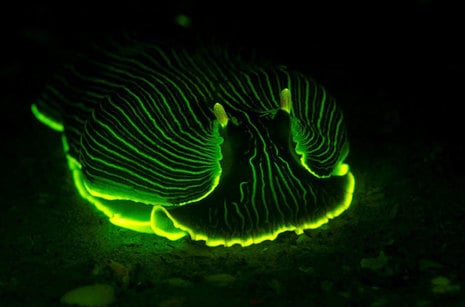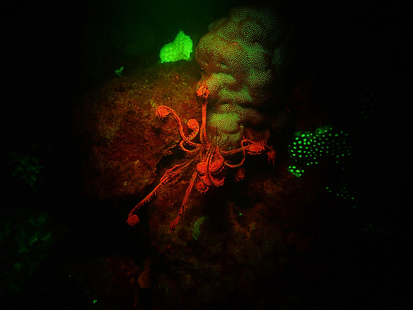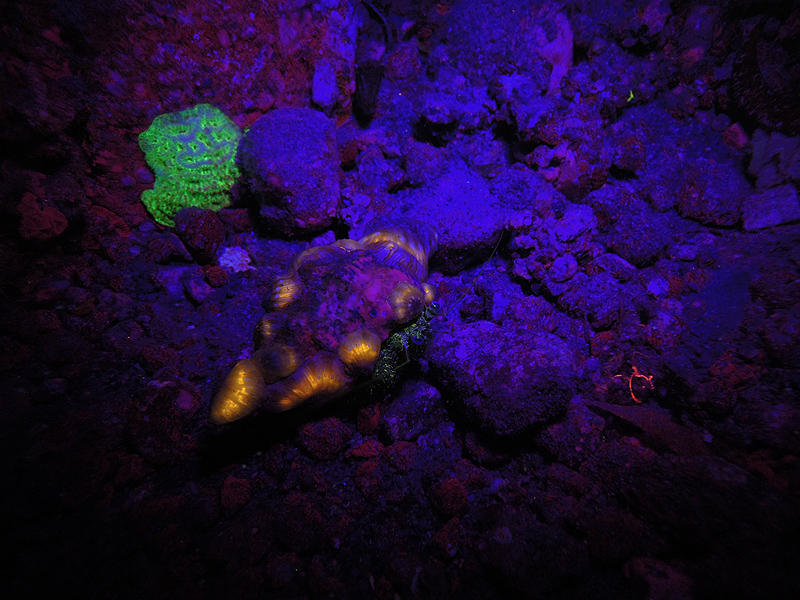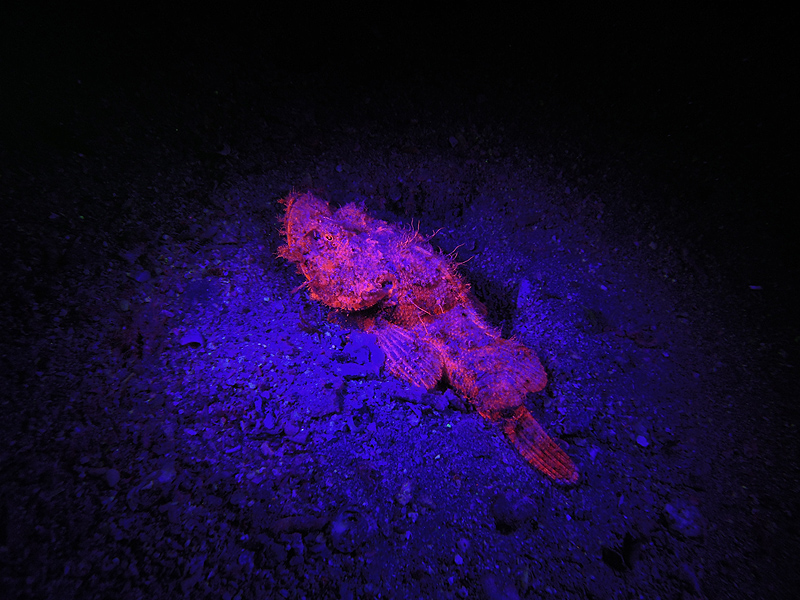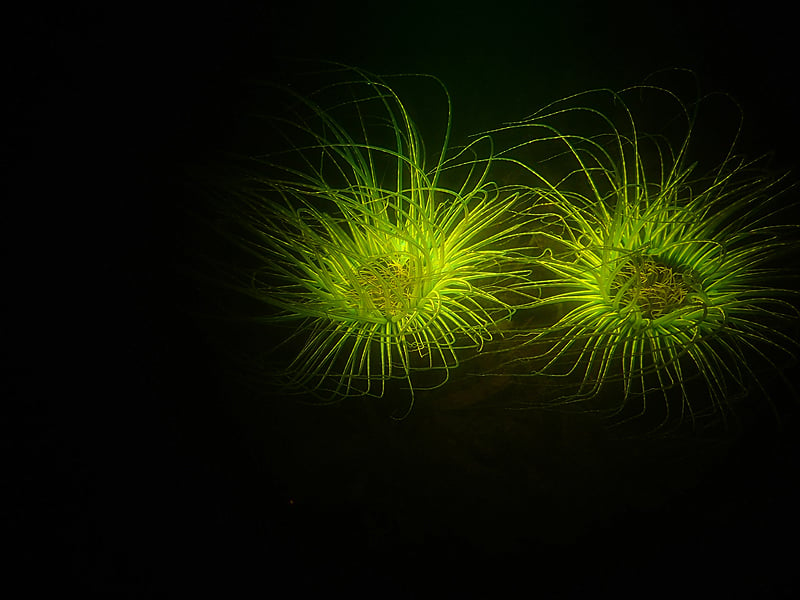Fluorescent diving in Japan
You have been diving in Japan for some time? You think your local diving site has nothing new to show you? It is time to re-discover some divesites and shed a new light on them….. Fluorescent Night Diving!
What is "Fluo-diving" and why would I make a "Fluo-dive?
A photo says more than a thousand words so have a look below.
What is "Fluo-diving" and why would I make a "Fluo-dive?
A photo says more than a thousand words so have a look below.
Divers are always looking for new ways to experience the wonders of the underwater world. One increasingly popular diving technique, called fluorescence or fluo night diving, gives divers the ability to observe marine creatures in brilliant, glowing colors invisible to the naked eye. Divers often refer to the colorful images of the movie Avatar after doing their first fluo dive. Imagine floating through a neon lit realm with corals and creatures glowing in the dark.
During our fluorescent night diving, we experience such scenes with our own eyes. We descend with our specialised lights. In combination with a special filter, this dive light allows us to see marine fluorescence.
How can I participate in this fluo night diving? What experience do I need?
Since we are using lights with a limited spectrum and filters on our diving masks, there is a limited visibility compared to a normal night dive. We do expect people to be certified divers proficient in buoyancy control, have a minimum of 20 logged dives and a minimum of 5 logged night dives. If you lack experience for these night dives, you can always join our group to get more dives and increase your experience. Alternatively, we can actively increase your diving skills and offer the PADI Night diver specialty and/or PADI Peak Performance Buoyancy specialty.
For people who are proficient and regular (night) divers, we will do one or two dives during the daytime to become familiar with the sites you will be
diving at night. The purpose is to practice buoyancy skills, study local flora and fauna, practice navigation techniques and in general, become comfortable with the equipment. During the day, we cover planning, organization, procedures, techniques, problems and risks of night dives with fluorescence and its associated equipment to ensure these dives are done in the utmost safety.
Last but not least, we will also explain how these lights can be used to check coral and reef health and will introduce participants to the PADI Project AWARE.
Interested to try? Just drop us message.
Please note that these special dives are organized on a limited basis and we can not always accommodate to do these dives anytime.
Why is marine life fluorescent? How does this work?
Due to the property of some marine life, they will re-emit light with a longer wavelength (visible) when you light them with (invisible) UV light.
Many marine organisms (for example: coral, anemones, jellyfish, sponges, anemones, jellyfish, clams, nudibranchs, shrimp, crabs and some fish) produce proteins which have the property to react to certain wavelengths of light with a phenomenon which is called "fluorescence". This protein is also called the "Green Fluorescent Protein“ (GFP).
Using blue light versus ultraviolet light
Research has shown that ultraviolet light is about four times less efficient to excite fluorescence in the Green Fluorescent Protein (GFP) than blue light of the same energy. Also blue light is less damaging than UV light when accidentally shing in the eyes of your dive buddy. For safety and best effect is why the diving lights used by DiveZone Tokyo are using blue LEDs so you can enjoy this color festival to its best potential.
During our fluorescent night diving, we experience such scenes with our own eyes. We descend with our specialised lights. In combination with a special filter, this dive light allows us to see marine fluorescence.
How can I participate in this fluo night diving? What experience do I need?
Since we are using lights with a limited spectrum and filters on our diving masks, there is a limited visibility compared to a normal night dive. We do expect people to be certified divers proficient in buoyancy control, have a minimum of 20 logged dives and a minimum of 5 logged night dives. If you lack experience for these night dives, you can always join our group to get more dives and increase your experience. Alternatively, we can actively increase your diving skills and offer the PADI Night diver specialty and/or PADI Peak Performance Buoyancy specialty.
For people who are proficient and regular (night) divers, we will do one or two dives during the daytime to become familiar with the sites you will be
diving at night. The purpose is to practice buoyancy skills, study local flora and fauna, practice navigation techniques and in general, become comfortable with the equipment. During the day, we cover planning, organization, procedures, techniques, problems and risks of night dives with fluorescence and its associated equipment to ensure these dives are done in the utmost safety.
Last but not least, we will also explain how these lights can be used to check coral and reef health and will introduce participants to the PADI Project AWARE.
Interested to try? Just drop us message.
Please note that these special dives are organized on a limited basis and we can not always accommodate to do these dives anytime.
Why is marine life fluorescent? How does this work?
Due to the property of some marine life, they will re-emit light with a longer wavelength (visible) when you light them with (invisible) UV light.
Many marine organisms (for example: coral, anemones, jellyfish, sponges, anemones, jellyfish, clams, nudibranchs, shrimp, crabs and some fish) produce proteins which have the property to react to certain wavelengths of light with a phenomenon which is called "fluorescence". This protein is also called the "Green Fluorescent Protein“ (GFP).
Using blue light versus ultraviolet light
Research has shown that ultraviolet light is about four times less efficient to excite fluorescence in the Green Fluorescent Protein (GFP) than blue light of the same energy. Also blue light is less damaging than UV light when accidentally shing in the eyes of your dive buddy. For safety and best effect is why the diving lights used by DiveZone Tokyo are using blue LEDs so you can enjoy this color festival to its best potential.
Some more photo impressions:
Photos copyright of Steffen Beyer and used with permission.
